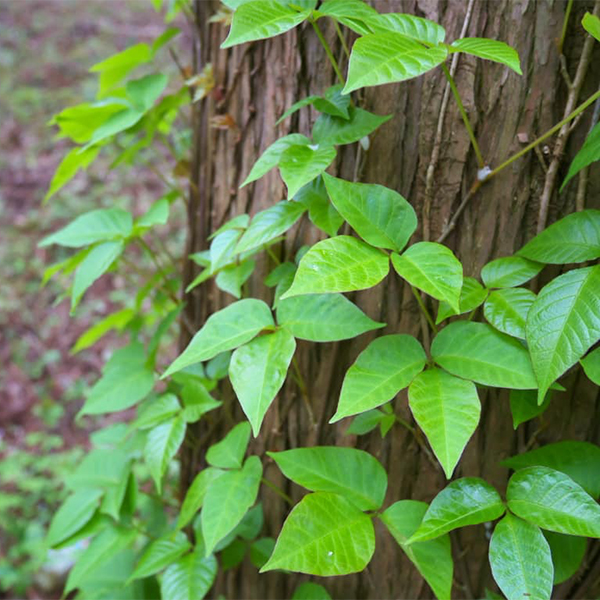It seems to me that poison ivy (Toxicodendron radicans) has become a much bigger problem in my garden over the last several years, and this year it seems especially robust. Scientists confirm that higher levels of carbon dioxide in the atmosphere tend to enhance the growth of many weedy plants, including poison ivy. Mature vines produce seeds that are readily distributed by birds, and uncontrolled seedlings grow rapidly, even in deep shade, re-rooting along their stems.
Poison ivy is native and grows in several forms: a vine trailing along the ground which re-roots along the stem; a shrub-like plant reaching as high as four feet; a climbing vine that can grow on shrubs and attaches to trees or another support. In New England, all forms have distinctive 3-lobed glossy leaves which, along with their stems and roots, release the toxic skin irritant named urushiol. I’m very sensitive to the skin rash it produces, so controlling poison ivy around my yard has become a prime concern.
Fortunately, late summer is the ideal time of year to eliminate poison ivy (and also many other woody vines like bittersweet, grapes, Virginia creeper and Baltic ivy). This is the time in their life cycle when woody plants are preparing for winter dormancy by building roots for their period of rest. When we disrupt this root-building process, we weaken them and reduce their ability to survive the winter.
Physically pulling poison ivy roots from the ground can be an effective control, provided the roots are entirely removed. But because of the toxicity of all its parts, this can be a risky process. Older plants tend to have extensive root systems or multiple attachments to the ground that are difficult to eliminate in their entirety, and remaining roots often enable the vines to survive. I personally prefer applying a chemical herbicide, which is probably the safest and most effective way to control poison ivy.
Chemical herbicides can be classified by how their application affects plants.
- Non-selective herbicides, including Glyphosate (such as Roundup) affect plants by interfering with the synthesis of the essential amino acids that are needed for the plant to grow. These herbicides damage all plants they contact.
- Selective herbicides, which include chemicals like 2,4-D, 2,4-DP, dichlorprop, dicamba, or triclopyr (labeled “poison ivy and brush killers”). These are growth regulators which damage or kill plants by causing rapid cell division and abnormal growth. These types affect broadleaf plants but do not damage grasses, so they can be used to manage woody weeds in lawns.
- Pre-emergent herbicides (such as Preen) prevent seeds from germinating and can control just-germinated seedlings. There are many types for controlling all types of weeds before their seeds germinate. Some formulations can cause damage to desirable plants—read the label!
My personal preference for controlling poison ivy is applying a growth-regulator-type (selective) brush killer in late summer. Glyphosate herbicides may also work to knock down top growth, but they are less effective destroying the root systems. A follow-up application of either type may be needed if re-growth appears or to treat missed areas. Be sure to apply herbicides while the leaves are still green–once their fall coloring begins, control is far less effective. Pre-emergent herbicides are not effective on mature plants.
All types of herbicides can cause damage to desirable plants, especially if improperly used. Be sure to apply the chemical as directed on the label, and always spray toward the ground. Pull down or cut any vines growing up tree trunks—herbicides applied to the bark or foliage of desirable trees and shrubs are likely to damage them. And never burn poison ivy branches or leaves (even dead ones!)—breathing their smoke can cause serious injury!
Check out this link to one of my favorite blogs that describes poison ivy in greater detail: https://awaytogarden.com/poison-ivy-with-dr-susan-pell/. I’m sure I’ll never completely eliminate poison ivy from my yard. But by being constantly vigilant, I’m reducing the chances of injury for me and my family and making my garden much more enjoyable.







